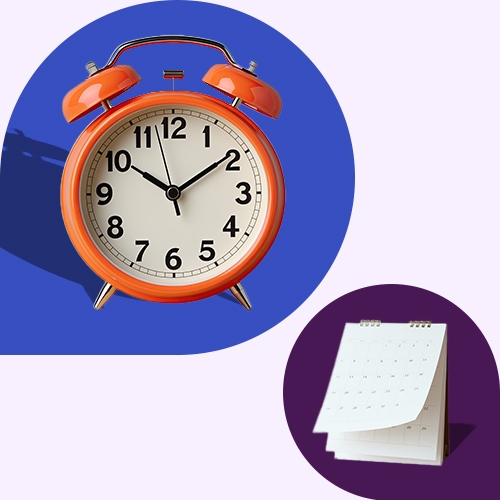The world moves quickly, pulling our attention in many directions. This makes mastering time management a crucial skill for success. Whether you’re a busy professional juggling projects, a student balancing coursework and extracurricular activities, or simply looking to regain control of your schedule, effective time management can help you meet or surpass deadlines and expectations.
This article examines practical, evidence-based strategies for prioritizing tasks and planning your time effectively. This, in turn, reduces stress and creates space for the work, activities, and people that matter most.
What is time management?
Time management involves planning how you allocate your time — choosing which activities to prioritize and how much time to devote to them — to boost productivity and efficiency. Instead of working harder, it focuses on working smarter by making intentional choices about task priorities, scheduling, and resource allocation.
The first step in time management is understanding where your time currently goes, then identifying your most important tasks and creating systems to ensure those priorities get the attention they need. The goal isn’t to cram more into your day; rather, it’s to focus on the highest-impact activities and give yourself enough time to perform them well.
Effective time management reduces stress by creating predictability and control over your schedule. You know what needs to be done and when, allowing you to make adjustments as needed. It also helps prevent rushed outcomes, such as waiting until the last minute to complete a project. This applies both at work and in your personal life, where balancing responsibilities with time for relationships and activities you enjoy can be challenging, especially while trying to meet individual goals.
Benefits of effective time management
Developing strong time management skills delivers both immediate and long-term benefits that extend far beyond simply getting more done.
Professional and academic benefits
In professional settings, strong time management enables you to meet goals on time, leading to better performance reviews, increased opportunities for advancement, and a reputation as a reliable and productive team member.
Similarly, research on time management in academic success reveals a positive correlation with greater self-control and enhanced study engagement. This indicates that students see benefits like higher grades, less academic stress from procrastination, and better readiness for future career demands.
Consistently meeting deadlines builds trust with instructors, mentors, colleagues, supervisors, and clients, creating a positive feedback loop that supports career growth.
Personal growth benefits
Effective time management allows for more free time to pursue hobbies, nurture relationships, and engage in self-care activities that boost overall well-being. When you’re not constantly scrambling to meet deadlines, you can invest in activities that promote personal development and life satisfaction. You’ll also notice lower stress levels as the anxiety from missed deadlines and overwhelming to-do lists decreases.
12 time management techniques that work
Follow these proven time management techniques and strategies to set yourself up for success:
1. Know where your time goes
Track your time for one week using an app like RescueTime or by recording it on paper. Identify patterns, time-wasters, and peak productivity periods. This awareness forms the foundation for all other improvements.
2. Set SMART priorities
Use the urgent-important matrix to categorize tasks. Focus on important but not urgent activities to avoid crises. Set SMART goals (Specific, Measurable, Achievable, Relevant, Time-bound) to maintain clarity and direction.
3. Use a planning tool
Choose a digital calendar like Google Calendar, project management software like Trello or Asana, or traditional planners. The key is to commit to one system instead of switching between multiple tools. Consider whether you can plan using tools you already use. For example, Slack offers the ability to track projects and create lists.
4. Organize your workspace
Reduce physical and digital clutter to minimize distractions. Create designated spaces (such as a home office or coffee shop) for different types of work. A clean and organized environment promotes mental clarity and faster task completion.
5. Schedule effectively
Practice time blocking by assigning specific time slots to different activities. Batch similar tasks together to stay focused. For example, checking email and updating your calendar can be done consecutively. Schedule demanding work when your energy is at its peak for maximum efficiency. Tools like Slack integrate with Google Calendar and other calendar apps to support scheduling.
6. Delegate when possible
Identify tasks others can handle and give clear instructions. Delegation frees up time for high-priority activities that need your specific skills and attention. For team coordination, explore time management tips at work to improve collaboration.
7. Beat procrastination
Try the Pomodoro Technique: Work for 25 minutes, then take a five-minute break. Or, use the two-minute rule: If something takes less than two minutes to complete, do it immediately instead of adding it to your to-do list. (And if you don’t like these two, try these additional tips for time management productivity.)
8. Manage distractions and time-wasters
Turn off non-essential phone and computer notifications during focused work periods. Use website blockers to mute social media during work hours. Set boundaries around phone use, email checking, and implement other time optimization strategies.
9. Avoid ineffective multitasking
Focus on single-tasking for better quality results. Multitasking consistently reduces productivity, leads to errors, and impacts brain health.
10. Set reminders and alarms
Use technology to stay on schedule with breaks, meetings, and deadlines. Automated reminders lessen mental load and help ensure important items aren’t overlooked.
11. Make time for breaks and fun
Schedule regular breaks to avoid burnout. Include enjoyable activities in your calendar; they’re not optional luxuries but vital for maintaining productivity and mental health. This can mean taking a quick walk or grabbing a favorite coffee or tea.
12. Stay healthy
Maintain a consistent sleep schedule, exercise regularly, and eat nutritious food. Physical health directly affects cognitive function, energy, and time management effectiveness. (Good time management also helps create space for activities like exercise.)
Create a personalized time management plan
Now let’s adapt these strategies to your lifestyle, needs, and career stage. Reflect on how you work best, test them out, and adjust as needed along the way.
- Identify your productivity style. Determine whether you’re naturally more productive in the morning or evening and plan your most important tasks accordingly. Think about your role — students may benefit from longer, focused study sessions, while professionals might prefer shorter work windows with regular check-ins with team members.
- Test and iterate. Implement new strategies gradually rather than overhauling your entire system all at once. Review what works and what doesn’t every week. Be open to adjusting your approaches as circumstances and responsibilities change. Small tweaks can have a big impact over time. Slack offers customizable features that help support evolving workflows.
- Stay flexible. Build buffer time into your schedule for unexpected demands or workplace “fire drills.” Develop contingency plans for when things don’t go as scheduled, reprioritize the most important tasks to stay on track with what’s urgent, and determine what can wait for another day. Flexibility helps prevent minor disruptions from derailing entire days.
Tools and resources to help you manage time
Here are some tools and techniques to help with organization and time management. When selecting from top task management software options, consider whether they integrate with an AI-powered work operating system like Slack.
Digital apps
Use technology to stay organized and focused.
- Trello offers visual project management through boards and cards to keep your projects and next steps organized.
- Todoist provides comprehensive task management with natural language processing.
- Google Calendar keeps your schedule organized and seamlessly integrates with other productivity tools.
- Notion combines note-taking, task management, and collaboration features.
For more suggestions and to see who offers advanced automation, explore the best AI tools for time management.
Analog tools
Grab your pen and paper to boost your time management.
- Bullet journals offer customizable, pen-and-paper systems for organization.
- Traditional planners provide structure without digital distractions.
- Sticky notes work well for quick reminders and visual organization.
Hybrid approaches
Leverage the advantages of both digital efficiency and traditional handwriting to boost productivity.
- Combine digital calendars for planning projects alongside handwritten daily task lists in a planner.
- Use apps for long-term planning and paper for immediate, tactical needs.
Time management is a personal responsibility, but business leaders can also support it by regularly reviewing tools and processes and encouraging teams to use productivity systems. Whenever possible, combine or integrate key tools so employees and students don’t have to switch between multiple tools and communication channels or manually (and mentally) track requests, resources, or updates to projects.
Three common mistakes to avoid in time management
Here are a few pitfalls of time management that can derail productivity:
- Overplanning without execution. Creating elaborate systems that become burdensome rather than helpful can lead to missed deadlines and require valuable time re-adjusting your schedule, rather than focusing on the highest-impact projects. Start simple and build complexity gradually.
- Ignoring rest and breaks. This results in burnout and lower productivity. Sustainable time management involves scheduling meal breaks and sufficient recovery time between focused work or study periods.
- Rigid scheduling without flexibility. Build in time buffers and maintain adaptable systems. If you don’t, you’ll feel stressed when unexpected demands come up or when you underestimate the time a task will take.
Perfectionism in planning can consume more time than the actual work. Trying to control everything is both impossible and draining. Aim to create systems that are “good enough” and that you’ll consistently use.
Give yourself more time for what matters
Effective time management is a skill that can be learned and improved through regular practice. Begin by applying one or two strategies that fit your current situation, then gradually develop a comprehensive system tailored to your needs. Keep in mind that the goal isn’t to pack every moment with productivity, but to intentionally make space for both work and rest.
The techniques outlined here lay a foundation, but your personal time management system should adapt as your responsibilities and goals change. Be patient with the process, celebrate improvements, and remember that even small adjustments in how you manage time can yield significant long-term benefits.
Time management FAQs
.






